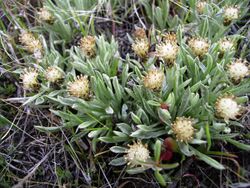Biology:Antennaria dimorpha
| Antennaria dimorpha | |
|---|---|

| |
| Antennaria dimorpha near Monitor, Chelan County Washington | |
| Scientific classification | |
| Kingdom: | Plantae |
| Clade: | Tracheophytes |
| Clade: | Angiosperms |
| Clade: | Eudicots |
| Clade: | Asterids |
| Order: | Asterales |
| Family: | Asteraceae |
| Genus: | Antennaria |
| Species: | A. dimorpha
|
| Binomial name | |
| Antennaria dimorpha | |
| Synonyms[1] | |
| |
Antennaria dimorpha is a North American species of flowering plants in the family Asteraceae known by the common names low pussytoes or gray cushion pussytoes.[2] It is native to western Canada (British Columbia, Alberta, Saskatchewan) and the western United States as far south as Riverside County in California and Rio Arriba County in New Mexico. It is generally found in dry areas. There are historical records of the species formerly occurring in northwestern Nebraska, but these populations appear now to be gone.[3]
Description
Antennaria dimorpha is a small mat-forming perennial herb growing in a flat patch from a thick, branching caudex. The spoon-shaped leaves are up to about a centimeter long and green but coated with long, gray hairs. The erect inflorescences are only a few centimeters tall and flowers often appear nestled among the foliage. Each stem holds a single flower head lined with dark brown and green patched phyllaries. It is dioecious, with male plants bearing heads of staminate flowers and female plants bearing heads of larger pistillate flowers. The fruit is an achene with a long, soft, barbed pappus. Older plants sometimes develop a dead spot in the center, with new growth forming a ring on the outside.
Habitat
Antennaria dimorpha grows in dry, open places in scablands, sagebrush desert, and ponderosa pine forest openings, often on very rocky soils.[4]
References
- ↑ The Plant List Antennaria dimorpha (Nutt.) Torr. & A.Gray
- ↑ Calflora taxon report, University of California, Antennaria dimorpha (Nutt.) Torrey & A. Gray Gray Cushion Pussytoes, low pussytoes
- ↑ Biota of North America Program 2014 county distribution map
- ↑ Burke Herbarium Image Collection| http://biology.burke.washington.edu/herbarium/imagecollection/taxon.php?Taxon=Antennaria dimorpha
External links
- Jepson Manual Treatment
- United States Department of Agriculture Plants Profile
- CalPhotos Photos gallery, University of California
Wikidata ☰ Q4771270 entry
 |

